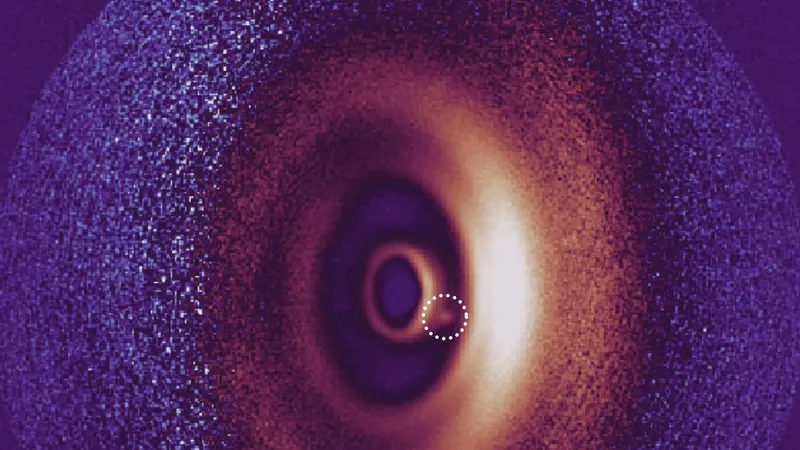
Astronomers Capture Rare Image of a Newborn Giant Planet
2025-08-30
Author: Sophie
Unlocking the Mystery of WISPIT 2b
In a groundbreaking discovery, astronomers have unveiled a brand-new gas giant, WISPIT 2b, nestled within a wide gap of dust and gas surrounding a youthful, sun-like star known as WISPIT 2. This extraordinary finding was made possible using the Very Large Telescope (VLT) operated by the European Southern Observatory.
Spotting Formation in Action
WISPIT 2b exhibits itself as a compact yet distinct source amidst a dark lane bordered by bright rings. It displays movement consistent with an orbital pattern. At just 5 million years old, the WISPIT 2 system provides a rare glimpse into the early stages of planetary formation.
Led by Richelle van Capelleveen of Leiden University, the research team collaborated across various institutions to validate the planet's existence. Their united efforts highlight the planet's significance in understanding the bizarre architectures of planetary systems.
A Window to Planetary Evolution
In total, nearly 6,000 confirmed exoplanets populate catalogs, though most remain unseen, inferred through their impact on starlight. Capturing a planet in its formative environment is a rare feat, allowing scientists to explore how colossal planets emerge and shape their surroundings.
The Imaging Breakthrough
Utilizing the VLT’s advanced SPHERE camera, the team isolated faint light emanating from the star’s vicinity, revealing a disk that stretches an astounding 35 billion miles across. One of the gaps within this disk is where the newly discovered planet resides.
As the observations progressed, the planet's position shifted in a manner consistent with gravitational patterns, further cementing its identification as a bound entity moving within the stellar system.
Climate and Composition
A notable observation was the strong H-alpha emission detected from WISPIT 2b, a characteristic signal indicating hydrogen is actively falling onto the planet, aiding in the ongoing development of its atmosphere. This discovery affirms that the young giant is still accumulating material from its surroundings.
Nature's Laboratory for Study
WISPIT 2b is the first clear example of a planet situated in a multi-ringed disk. This arrangement allows researchers to observe how a large body influences nearby dust and gas, offering a unique experimental setup for further study.
A Comparative Case for Future Research
Following previous discoveries, WISPIT 2b presents a sun-like system with well-defined ring structures and a formative planet orbiting at about 57 AU (5.3 billion miles). This clarity provides a robust framework for future investigations into giant planet formation.
The Road Ahead
Future observations, particularly via ALMA and JWST, are set to enhance our understanding of gas movement near the gap and analyze thermal emissions from the planet’s nascent atmosphere. These combined efforts can refine orbital dynamics and shape our comprehension of the links between planet mass and surrounding disk structure.
Significance of the Discovery
Van Capelleveen described the discovery as an ‘amazing experience,’ emphasizing that this clear and well-defined system provides an invaluable benchmark for ongoing and future planetary research. With such clarity, different research teams can align their models with the same measurements, facilitating progress in the understanding of planetary formation.









 Brasil (PT)
Brasil (PT)
 Canada (EN)
Canada (EN)
 Chile (ES)
Chile (ES)
 Česko (CS)
Česko (CS)
 대한민국 (KO)
대한민국 (KO)
 España (ES)
España (ES)
 France (FR)
France (FR)
 Hong Kong (EN)
Hong Kong (EN)
 Italia (IT)
Italia (IT)
 日本 (JA)
日本 (JA)
 Magyarország (HU)
Magyarország (HU)
 Norge (NO)
Norge (NO)
 Polska (PL)
Polska (PL)
 Schweiz (DE)
Schweiz (DE)
 Singapore (EN)
Singapore (EN)
 Sverige (SV)
Sverige (SV)
 Suomi (FI)
Suomi (FI)
 Türkiye (TR)
Türkiye (TR)
 الإمارات العربية المتحدة (AR)
الإمارات العربية المتحدة (AR)